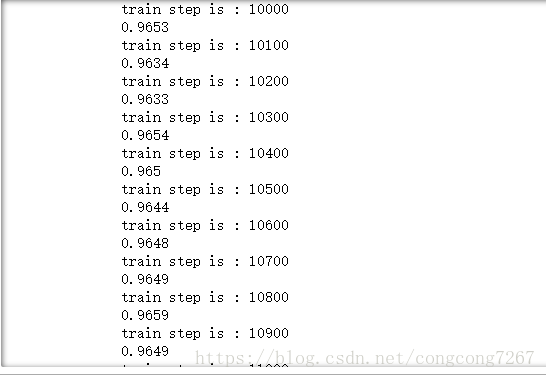卷积神经网络实现手写体识别
用卷积神经网络实现手写体识别比全连接网络效果好很多
本人用5层神经网络,其中3层卷积,2层全连接
数据集可以在我的网盘里下,去官网下很容易下载失败(本人就是下了许多次才下载下来),注意代码里的数据集路径,读者相应更改就可以。
网盘链接:https://pan.baidu.com/s/1DOvxTd6MtdRhJK18OERLMw 密码:zx1o
下面是本人的代码:
import tensorflow as tf
from tensorflow.examples.tutorials.mnist import input_data
# 载入数据集
mnist = input_data.read_data_sets('MNIST_data', one_hot=True)
def max_pool(x):
return tf.nn.max_pool(x, ksize=[1, 2, 2, 1],strides=[1, 2, 2, 1], padding='SAME')
x = tf.placeholder(tf.float32, [None, 784])
x_image = tf.reshape(x, [-1, 28, 28, 1])
k = 4
l = 8
m = 12
W1 = tf.Variable(tf.truncated_normal([5,5,1,k],stddev = 0.1))
b1 = tf.Variable(tf.ones([k])/10)
W2 = tf.Variable(tf.truncated_normal([5,5,k,l],stddev = 0.1))
b2 = tf.Variable(tf.ones([l])/10)
W3 = tf.Variable(tf.truncated_normal([5,5,l,m],stddev = 0.1))
b3 = tf.Variable(tf.ones([m])/10)
n = 200
W4 = tf.Variable(tf.truncated_normal([1*1*m,n],stddev = 0.1))
b4 = tf.Variable(tf.ones([n])/10)
W5 = tf.Variable(tf.truncated_normal([n,10],stddev = 0.1))
b5 = tf.Variable(tf.ones([10])/10)
y1 = tf.nn.relu(tf.nn.conv2d(x_image,W1,strides=[1,1,1,1],padding = 'SAME')+b1)
print(y1.shape)
y1 = max_pool(y1)
print(y1.shape)
y2 = tf.nn.relu(tf.nn.conv2d(y1,W2,strides=[1,2,2,1],padding = 'SAME')+b2)
print(y2.shape)
y2 = max_pool(y2)
print(y2.shape)
y3 = tf.nn.relu(tf.nn.conv2d(y2,W3,strides=[1,2,2,1],padding = 'SAME')+b3)
print(y3.shape)
y3 = max_pool(y3)
print(y3.shape)
yy = tf.reshape(y3,shape=[-1,1*1*m])
y4 = tf.nn.relu(tf.matmul(yy,W4)+b4)
print(y4.shape)
y = tf.nn.softmax(tf.matmul(y4, W5) + b5)
print(y.shape)
# 为了计算交叉熵,我们首先需要添加一个新的占位符用于输入正确值
y_ = tf.placeholder("float", [None, 10])
# 交叉熵损失函数
cross_entropy = -tf.reduce_sum(y_*tf.log(y))
#训练方法,学习率为1e-4
train_step = tf.train.GradientDescentOptimizer(1e-4).minimize(cross_entropy)
#初始化变量
init = tf.global_variables_initializer()
sess = tf.Session()
sess.run(init)
# 开始训练模型,循环训练1000次
for i in range(20000):
# 随机抓取训练数据中的100个批处理数据点
batch_xs, batch_ys = mnist.train.next_batch(100)
# 喂入数据,开始训练
sess.run(train_step, feed_dict={x: batch_xs, y_: batch_ys})
if(i%100 == 0):
print("train step is : "+str(i))
#计算正确率
correct_prediction = tf.equal(tf.argmax(y, 1), tf.argmax(y_, 1))
accuracy = tf.reduce_mean(tf.cast(correct_prediction, "float"))
print(sess.run(accuracy, feed_dict={x: mnist.test.images, y_: mnist.test.labels}))
# 检验真实标签与预测标签是否一致
correct_prediction = tf.equal(tf.argmax(y, 1), tf.argmax(y_, 1))
# 计算精确度,将true和false转化成相应的浮点数,求和取平均
accuracy = tf.reduce_mean(tf.cast(correct_prediction, "float"))
# 计算所学习到的模型在测试数据集上面的正确率
print(sess.run(accuracy, feed_dict={x: mnist.test.images, y_: mnist.test.labels}))
下面是效果截图:
由于本人电脑性能一般,所以只训练了20000轮,读者可以将训练轮数在加倍,正确率会更高。
如果出现过拟合现象,可以用dropout缓解。

